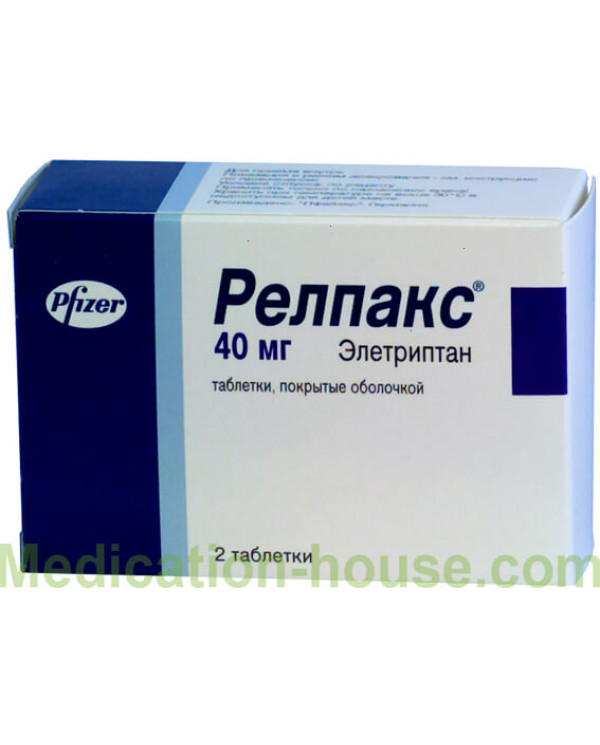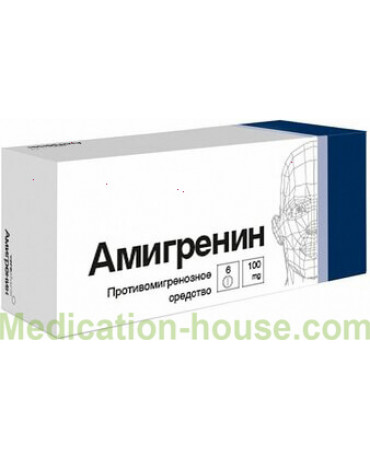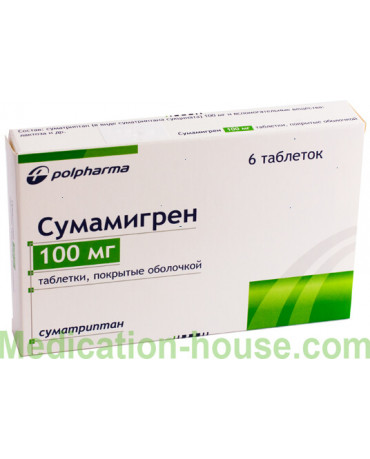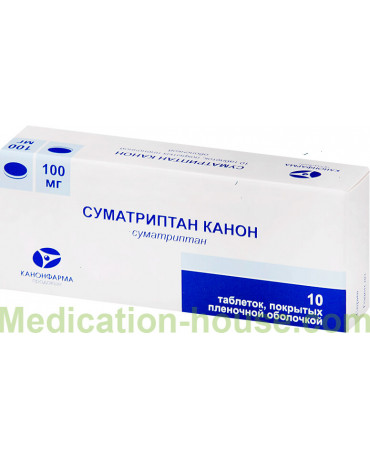Relpax instruction
You can buy Relpax here
Composition
One tablet contains:
the active substance is eletriptan hydrobromide 48.485 mg (equivalent to eletriptan 40 mg),
excipients: microcrystalline cellulose, lactose monohydrate, croscarmelose sodium, magnesium stearate,
composition of the film shell: Opadri orange OY-LS-23016 (hypromellose, lactose monohydrate, glycerol triacetate, titanium dioxide E171, sunset yellow aluminum varnish (E 110) (FD & C yellow No. 6 aluminum varnish)), Opadri transparent YS-2-19114- A (hypromellose, glycerol triacetate).
Pharmacokinetics
Suction
After ingestion, eletriptan is rapidly and well absorbed in the gastrointestinal tract (about 81%). Absolute bioavailability when administered orally in men and women is about 50%. The time to reach the maximum concentration (Tmax) averages 1.5 hours after ingestion. In the range of therapeutic doses (20-80 mg), a linear dependence of pharmacokinetics has been established.
Eating fatty foods increases the maximum concentration (Cmax) of eletriptan and the area under the curve “concentration - time” (AUC) by about 20-30%. When administered during a migraine attack, the AUC decreased by about 30%, and Tmax increased to 2.8 hours. With regular use (20 mg three times a day) for 5-7 days, eletriptan's pharmacokinetics remained linear with the expected cumulation. With the appointment of higher doses (40 mg three times a day and 80 mg twice a day) for 7 days, eletriptan cumulation exceeded the expected (approximately 40%).
Distribution
The volume of distribution of eletriptan is 138 liters, which indicates a good distribution in the tissues. Eletriptan binds moderately to plasma proteins (approximately 85%).
Metabolism
The primary metabolism of eletriptan occurs under the action of the CYP3A4 isoenzyme of cytochrome P450 in the liver. This fact is confirmed by an increase in plasma concentrations of eletriptan, while being used with erythromycin, which is a potent selective CYP3A4 inhibitor. There is also a slight involvement of CYP2D6 in eletriptan metabolism, although in laboratory studies there is no clinical significant effect of this enzyme polymorphism on the pharmacokinetic parameters of eletriptan.
Two major circulating metabolites have been identified, the proportion of which is a significant part of the total radioactivity of blood plasma after administration of eletriptan labeled with C14. The metabolite resulting from N-oxidation is not active. The metabolite resulting from N-demethylation is comparable in activity to eletriptan. The third component of radioactive plasma is not identified; it is believed to be a mixture of hydroxylated metabolites, which are also excreted in the urine and feces.
The concentration of the active N-demethylated metabolite in the blood plasma is only 10–20% of the concentration of eletriptan administered and, accordingly, are not of great importance for the development of the therapeutic effect of eletriptan.
Removal
The total clearance of eletriptan from plasma after intravenous administration averages 36 l / h, and the half-life is approximately 4 h. The mean renal clearance after oral administration is approximately 3.9 l / h. The share of non-renal (metabolic or hepatic) clearance is approximately 90% of the total clearance; this indicates that eletriptan is excreted mainly as metabolites in urine and feces.
Pharmacokinetics in special groups of patients
Gender
Gender has no clinically significant effect on plasma plasma levels of eletriptan.
Older people (over 65)
Compared to younger people, elderly patients (65-93 years) have a statistically significant reduction in eletriptan clearance (16%), which is associated with a statistically significant increase in the half-life of the drug (from about 4.4 hours to 5.7 hours).
Therefore, the effect of eletriptan on blood pressure in the elderly may be more pronounced compared with younger patients.
Liver dysfunction
In patients with hepatic insufficiency (Child-Pugh class A and B), a statistically significant increase in both AUC (by 34%) and half-life was observed. There was a slight increase in the Cmax value (by 18%). This small change is not considered clinically significant.
Renal dysfunction
In patients with mild renal failure (creatinine clearance 61–89 ml / min), moderate (creatinine clearance 31–60 ml / min) and severe (creatinine clearance <30 ml / min) no statistically significant changes in eletriptan pharmacokinetics were observed or levels of plasma protein binding.
Pharmacodynamics
Eletriptan - the active ingredient of Relpax, is an effective and selective agonist of vascular 5-HT1B and neuronal 5-HT1D serotonin receptors, located mainly in the vessels of the brain; when they are stimulated, vasoconstriction occurs, which leads to a decrease in migraine pain. Eletriptan also has a high affinity for 5-HT1F serotonin receptors, which may be related to its anti-migraine mechanism of action, and has a moderate effect on 5-HT1A, 5-HT2B, 5-HT1E and 5-HT7 serotonin receptors.
Compared to sumatriptan, eletriptan shows significantly greater selectivity for receptors located in the carotid arteries than in the coronary and femoral vessels. Eletriptan's ability to constrict intracranial blood vessels causes its anti-migraine efficacy. Eletriptan also has the ability to reduce neurogenic inflammation of the dura mater.
Clinical efficacy and safety
The efficacy and safety of Relpax in relieving migraine attacks has been proven in 10 placebo-controlled clinical trials involving more than 6,000 patients. The anti-migraine effect occurred already 30 minutes after oral administration of the drug dose and after 2 hours was significantly higher than that of placebo at all dosages and had the following values: 59-77% (80 mg), 54-65% (40 mg) , 47-54% (20 mg) and 19-40% (placebo).
Relpax has also been shown to be effective in treating migraine-related symptoms, such as vomiting, nausea, photophobia, and phonophobia.
Patients who had a therapeutic response to Relpax had a low relapse rate, which was largely proportional to the dose of the drug.
Indications for use
- relief of migraine attacks with or without aura
Dosage and administration
Inside.
Tablets should be swallowed whole with water.
Relpax tablets are recommended to be used immediately after the onset of a migraine attack, the effect of the drug does not decrease even when taken at a later stage of a migraine attack. Relpax should not be taken prophylactically.
Adults (18-65 years old)
The recommended starting dose is 40 mg.
In case of recurrence of headaches within 24 hours: if the migraine headache is relieved, but then resumes within 24 hours, Relpax can be re-administered in the same dose. If a second dose is needed, it should be taken no earlier than 2 hours after the first dose.
In the absence of effect: if the first dose of Relpax does not lead to a decrease in headache within 2 hours, then the second dose should not be taken to relieve the same attack, since the effectiveness of such treatment has not been proven. However, clinical studies have shown that the majority of patients who did not have a curative response to the first migraine attack showed an effective clinical response during the next attack.
If taking the drug in a dose of 40 mg does not allow to achieve an adequate effect,
then during subsequent migraine attacks, an 80 mg dose may be effective. The maximum daily dose should not exceed 160 mg.
Older people (over 65)
Due to the small number of patients over 65 years of age who participated in clinical trials, the safety and efficacy of the drug for the elderly have been studied insufficiently. It is also explained more frequently by this group of the population with adverse reactions associated with arterial hypertension, compared with younger people.
Liver failure
For patients with mild to moderate hepatic insufficiency, correction in the dosage of the drug is not required. Given that the safety of the drug for people with severe liver failure has not been investigated, the use of Relpax in such patients is contraindicated.
Renal failure
Taking into account that in the case of kidney failure, the hypotensive effect of Relpax is enhanced, doses of more than 40 mg should be used in such patients with caution.
Side effects
In general, Relpax is well tolerated. Usually, side effects are transient, mild or moderate, and go away on their own without additional treatment. The frequency and severity of adverse reactions in patients taking the same dose twice to relieve an attack are similar to those in patients taking it once.
The following adverse reactions (incidence ≥1% and higher than that of placebo) were observed in patients who took therapeutic doses of the drug during clinical trials.
Often
- dizziness, headache, hypesthesia, male, paresthesia, drowsiness
- arterial hypertension, heart palpitations, tachycardia, feeling of warmth and rush of blood, pain, constriction, pressure in the chest
- vertigo
- pharyngitis, feeling of "lump" in the throat
- abdominal pain, dry mouth, indigestion, nausea
- increased sweating
- back pain, myalgia
- asthenia, chills
Often encountered adverse events observed with the use of eletriptan preparations are typical side effects for the entire class of 5-HT1 receptor agonists.
During post-registration use, the following adverse reactions have been reported:
- allergic reactions: itchy skin, rash, urticaria, including such serious as angioedema
- arterial hypertension
- vomiting
Seldom
- fainting
- ischemic colitis
Contraindications
hypersensitivity to eletriptan or to any other component of the drug
severe liver dysfunction
children and adolescents under 18 years of age (since the efficacy and safety of the drug in this age group are not precisely established)
The following contraindications to the use of eletriptan are based on its pharmacodynamic properties:
uncontrolled arterial hypertension
coronary heart disease (angina pectoris, Prinzmetal angina pectoris, myocardial infarction, confirmed asymptomatic ischemia of the cardiac) or suspicion of its presence
peripheral vascular diseases
history of cerebrovascular accident or transient ischemic attack
use of ergotamine and its derivatives (including methysergide) within 24 hours before or after taking eletriptan (see the section “Drug Interactions”)
simultaneous administration of eletriptan with other 5-HT1 receptor agonists
Drug interactions
Effect of other drugs on eletriptan
During clinical trials of eletriptan, no cases of drug interactions with beta-blockers, tricyclic antidepressants, selective serotonin reuptake inhibitors and flunarazine were reported.
Population pharmacokinetic analysis in clinical studies suggests that the following drugs (beta-blockers, tricyclic antidepressants, selective serotonin reuptake inhibitors, hormone replacement therapy based on estrogen, oral contraceptives containing estrogen and calcium channel blockers) have a low probability of effect on the pharmacokinetic properties of eletriptan.
Eletriptan is not a substrate of monoamine oxidase (MAO). Therefore, no interaction between eletriptan and MAO inhibitors is expected.
In clinical studies on the interaction with propranolol (160 mg), verapamil (480 mg) and fluconazole (100 mg), eletriptan Cmax increased 1.1, 2.2 and 1.4 times, respectively. An increase in eletriptan AUC was 1.3, 2.7 and 2.0, respectively. These effects are not considered clinically significant, and did not cause an increase in blood pressure or an increase in adverse events compared to taking eletriptan alone.
With the simultaneous appointment of erythromycin (1000 mg) and ketoconazole (400 mg), which are powerful specific inhibitors of CYP3A4, a significant increase in Cmax (2 and 2.7 times, respectively) and AUC (3.6 and 5.9 times) of eletriptan was detected. These effects were accompanied by an increase in T1 / 2 of eletriptan from 4.6 to 7.1 h when using erythromycin and from 4.8 to 8.3 h when using ketoconazole (see the Pharmacokinetics section). Therefore, Relpax should not be used in combination with powerful inhibitors of CYP3A4, in particular ketoconazole, itraconazole, erythromycin, clarithromycin, josamycin and protease inhibitors (ritonavir, indinavir and nelfinavir).
Ingestion of caffeine / ergotamine 1 and 2 hours after Relpax leads to a small but additive increase in blood pressure, which could be predicted on the basis of the pharmacological properties of these drugs. In this regard, drugs containing ergotamine or ergotamine-like agents (for example, dihydroergotamine) should not be administered within 24 hours after taking Relpax®. Conversely, Relpax can be prescribed no earlier than 24 hours after taking ergotamine containing preparations.
Effect of eletriptan on other drugs
Relpax in clinical doses does not inhibit or does not induce cytochrome P450 enzymes, including CYP3A4 enzymes that metabolize drugs, therefore, the clinically significant interaction of Relpax, due to the effect on these enzymes, is unlikely.
Interaction with serotonergic drugs
The combined use of 5-HT receptor agonists, including eletriptan, and drugs that have serotonergic effects, including selective serotonin reuptake inhibitors and norepinephrine reuptake inhibitors and serotonin, can increase the risk of serotonin syndrome. If combined treatment with eletriptan and serotonergic drugs is clinically indicated, it should be used with caution. Especially careful monitoring of patients is required in the initial stage of therapy, as well as increasing the dosage of any of the drugs.
special instructions
Serotonin syndrome
Combined use of eletriptan with other drugs that have serotonergic effects, such as SSRIs (norepinephrine and serotonin reuptake inhibitors) and SSRIs (selective serotonin reuptake inhibitors), should be used with caution, as there are reports of a small number of cases of serotonin syndrome in combination the use of eletriptan and other network orinergic drugs (see the section “Drug interactions” - Interaction with serotonergic mi drugs).
Use of Relpax in combination with powerful inhibitors of CYP3A4, in particular ketoconazole, itraconazole, erythromycin, clarithromycin, josamycin and protease inhibitors, is not recommended.
such as ritonavir, indinavir and nelfinavir (see “Drug Interactions”).
Like other 5-HT1 receptor agonists, Relpax should be used only in when the diagnosis of migraine is beyond doubt. Relpax is not indicated for the relief of hemiplegic, ophthalmoplegic, or basilar migraine.
Relpax is effective in the treatment of migraine with and without aura and migraine accompanying the menstrual cycle. Relpax, taken during the onset of aura, does not prevent the development of a headache; therefore, it should be taken only during the headache phase.
Relpax, like other 5-HT1 receptor agonists, should not be prescribed for the treatment of "atypical" headaches, which can be associated with serious diseases (stroke, rupture of the aneurysm), when the narrowing of cerebral vessels can be harmful.
Relpax should not be taken prophylactically.
Relpax should not be prescribed without a preliminary examination in patients who are likely to have or are at increased risk of cardiovascular diseases (see section “Contraindications”). The use of eletriptan in patients with heart failure has not been studied. As in the case of other 5-HT1 receptor agonists, the use of the drug in such patients is not recommended.
In patients with mild or moderate hepatic impairment, a dose change is not required. Relpax is contraindicated in patients with severely impaired liver function.
In patients with impaired renal function, the hypertensive effect of Relpax is enhanced, therefore dosages exceeding 40mg should be used with caution. When using Relpax in doses of 60 mg or more (in the range of therapeutic doses), a small and transient increase in blood pressure was recorded. Blood pressure increased to a greater extent in patients with impaired renal function and the elderly (such changes were not accompanied by clinical consequences).
Patients suffering from chronic headaches, as a rule, abuse various triptannymi drugs. Excessive uncontrolled use of any anti-migraine drugs can lead to more frequent headaches.
Pregnancy and lactation
Relpax should be prescribed only in cases where the expected benefit to the mother greatly exceeds the possible risk to the fetus.
Relpax is excreted in breast milk. In the study of 8 women who took a single dose of 80 mg, the average total eleptriptan content in breast milk after 24 hours was 0.02% of the dose. However, care should be taken when using the drug in breastfeeding women. The risk of exposure to the newborn can be minimized if not breastfed for 24 hours after eletriptan is taken.
Features of the effect of the drug on the ability to drive a vehicle or potentially dangerous machinery
In some patients, migraine itself or the administration of 5-HT1 receptor agonists, including Relpax, may be accompanied by drowsiness or dizziness. Patients when performing tasks requiring increased attention, such as driving and working with complex mechanisms, should be careful during migraine attacks and after taking Relpax.
Overdose
When taking single doses of 120 mg, no clinically significant adverse reactions were observed.
Symptoms: arterial hypertension or other more serious disorders of the cardiovascular system.
Treatment: carry out the usual maintenance therapy. The elimination half-life of eletriptan is about 4 hours, so in case of overdose of this drug, patients should be observed for at least 20 hours or until the clinical symptoms disappear.
The effect of hemodialysis and peritoneal dialysis on serum concentrations of eletriptan is not known.
Release form and packaging
40 mg coated tablets.
2, 4 tablets in a blister pack of polyvinyl chloride and aluminum foil. On 1 blister strip packaging together with the instruction for medical application in the state and Russian languages in a cardboard pack.
Storage conditions
Store at a temperature not higher than 30 ° C.
Keep out of the reach of children!
Shelf life - 3 years.
Do not use after the expiration date printed on the package.
Terms of sell
You can buy Relpax without a prescription.




